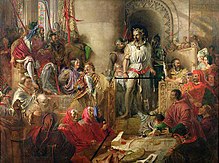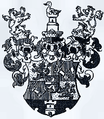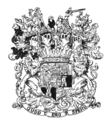Wallis of Carrighmain

The family of the Counts of Wallis, Barons of Carrighmain or Karighmain also Counts of Wallis on Carrighmain originally came from France . It gained estates and reputation in Ireland and Scotland . A branch of the family then entered the Imperial Austrian service. Members of the family held influential court and state offices and made numerous officers in the imperial army . They founded libraries in all of their Bohemian and Moravian castles, the most extensive in Koleschowitz , Mährisch Budwitz and Budischkowitz .
history
In Ireland and Scotland
The family of the Valais von Carrighmain is a very old family, originally French according to Ernst Heinrich Kneschke , who owned the castle and area of Karighmain in Ireland as early as the second half of the 12th century, at the time of King Henry II of England the same still now bears the baronial title, as well as owned Scottish goods on the slopes of the Valais mountains. William Wallace (also: "William Walsh") is mentioned among the Scottish barons who stood in the dispute over the succession of the houses Balliol and Bruce to the house Balliol . According to Norman Davies , he came from a Cumbrian family of the former Kingdom of Strathclyde , since his last name Wallace ( Uallas ) means Welsh. The determination of the name of his father is also not clear, he is handed down as Malcolm Wallace, but the knight David Wallace from the entourage of James Steward , who came from Riccarton near Galston in Ayrshire, is also available. When Johann von Balliol was recognized as King of Scotland in 1291 , this William Wallace rose with the same against Edward I of England ("Edward Longshanks") , who claimed supremacy over Scotland. William Wallace, who was nicknamed "Hero of Scotland" by the people as a result of the Battle of Irvine and Sterling (1297), was honored by his king: Because of the bold defense of the Bridge of Sterling, the King of Scotland asked William to himself to ask a mercy. Thereupon William raised his white, blood-stained standard and said: "Quod ero - spero" ["Let me be what I dare to hope"], whereupon the king ordered that the coat of arms, the erect, silver lion in Blue covered with a cross, half silver, half red armband, and the aforementioned words should be accepted as a motto by the gentlemen of Karighmain. After the victory over England he was appointed as a knight to the Guardian of Scotland , but he was defeated on July 22, 1298 by Edward at the Battle of Falkirk . Afterwards he probably stayed temporarily in France and was betrayed in 1305 and captured near Glasgow and executed in London for treason against Edward I. Later the Lords of Karighmain flourished in Scotland and Ireland for several centuries and were connected by marriages to the most distinguished houses. After his father Richard's death, his older son Theobald returned to the British Isles , where with the reign of Charles I, conditions were more favorable for the Catholic vassals and where the name Wallis (Walsh) still lives on in the English and Irish baronages.
In Austria
In 1622 Richard Wallis of Carrickmines , ( County Dublin ) († November 1632) with his sons Theobald and Olivier, to escape the persecution of Catholics under Oliver Cromwell , left the ancestral property and turned to Germany, where all three were among the first Irish Were officers who served in the army of Emperor Ferdinand II . Richard, kk colonel , died in Magdeburg from the wounds received in the battle of Lützen . While his older son returned to his old homeland, (see above), the younger son Olivier (* 1600; † June 21, 1667) stayed in Germany and rose from honorary position to honorary position in the Thirty Years' War . The same received a regiment, the Bohemian Inkolat with the barons on December 12, 1651 and the rank of chamberlain. Before that he was decorated with a golden chain of mercy as proof of the recognition of his bravery, proven in 1645 before Olomouc . The baron later became the commandant of Sathmar , advanced to general field sergeant (rank of January 5, 1666) and died as the commanding general on the other side of the Tisza . He was the common progenitor of the two lines of the count's family that then emerged. The first of these lines was donated by the older son of Baron Olivier, Ernst Georg, and the second by the younger son, Franz Ernst. The descent of the members of both lines results in the following pedigree:
First line on Kolleschowitz:
Ernst Georg , son of Olivier (* 1637; † September 6, 1689), kk real chamberlain, master of Welchau, Kunzendorf and Kolleschowitz , also chose the military career, was sergeant general on September 5, 1685, lieutenant field marshal on October 7, 1688 and died at the siege of Mainz in 1689 . With his wife, Countess Maria Magdalene von Attems-Petzenstein (1657–1712), he fathered several children, including the two later highly respected officers:
- Georg Olivier Graf von Wallis (1673–1744) was a real Privy Councilor, Governor of Messina and an Imperial Field Marshal . His second wife, Countess Maria Theresa von Kinsky (* October 18, 1721 - August 13, 1752), he married on August 18, 1743. Their son Stephan Olivier (* October 1, 1744; † February 5, 1832) was master of the lordship Koleschowitz, Petrowitz etc., Imperial Chamberlain and Lower Austrian Government Councilor. He married on May 3, 1766 with Maria Franziska Countess von Colloredo (* April 2, 1746, † January 25, 1795). Rudolph Olivier (* July 30, 1767; † June 18, 1833), Herr zu Koleschowitz, Petrowitz and Hoch-Lihin, kk chamberlain, major and first stable master, married Countess Eleonore von Kollonitz von Kollograd on October 25, 1797(* 2. July 1776 - † April 8, 1827). Their son Friedrich Olivier continued the line.
- Franz Paul Count of Wallis (1678-1737), General Feldzeugmeister and hereditary lord of Kunz village in the then directly to Bohemia belonging Glatz .
Both of them, as well as their brother Johann Hugo, were granted the hereditary-Austrian and Bohemian count status by Emperor Joseph I on March 18, 1706 in Laxenburg with the name Count of Wallis, Barons of Karighmain.
With the death of Count Georg (see below), great-grandson of Georg Olivier, on December 13, 1928, this branch of the male line and with him the family in Austria became extinct.
2nd line on Budwitz:
Franz Ernst († December 12, 1702), baron and kk real chamberlain, younger son of Olivier and brother of Ernst Georg, married Anna Theresia von Rziczan († 1722). His son Franz Wenzel (* October 4, 1696; † January 14, 1774), Lord of Budwitz , was a real Privy Councilor, Knight of the Order of the Golden Fleece and an officer, on: January 3, 1734 Sergeant General, March 31, 1735 Lieutenant Field Marshal , June 27, 1745 Feldzeugmeister, June 30, 1754 Field Marshal . He received from Emperor Charles VI. on July 14, 1724 the imperial count in Vienna and after his appointment as field marshal lieutenant on May 16, 1736 together with the brothers Patricius and Robert Freiherrn von Wallis and their cousins Edmund, Philipp and Olivier also the Austrian and Bohemian count. He married Maria Rosa Regina Countess of Thürheim (* September 7, 1705; † March 20, 1777) on July 23, 1726. Their eldest son Franz Ernst (II.) (* February 23, 1729; † April 18, 1784) was kk chamberlain, real secret council, vice-court of appeal-president and colonel court feudal judge in Bohemia. Since October 17, 1759, his wife was Countess Maria Maximiliane von Schaffgotsche (* February 6, 1741; † after 1805). Son Joseph (* August 31, 1767; † November 18, 1818) was Minister of State and Conference, married on September 11, 1788 to Countess Maria Luise von Waldstein-Dux (* June 11, 1768; † around 1828).
Their son Maximilian (* June 27, 1789; † July 30, 1864), married since July 4, 1819 to Maria Countess von Hoyos (* July 22, 1800, † December 4, 1882), continued this branch of the family; it became extinct in the male line with the death of his grandson, Count Josef (born February 9, 1862) on December 1, 1928.
Josef's sister Marie, married to Rudolf Altgrafen zu Salm-Reifferscheidt-Raitz (* 1866, † 1919), died on April 23, 1936 in Budischkowitz as the last representative of her gender in the Austrian lands.
Other representatives
- Franz Olivier Graf von Wallis (born September 26, 1838 - February 1, 1895), officer, on: November 1, 1886 (rank of October 25 of the year) Major General, May 1, 1891 Lieutenant Field Marshal ad honores and retired.
- Franz Wenzel Graf von Wallis (1696–1774), Austrian field marshal , kuk chamberlain, colonel of the Old Wallis regiment and knight of the Order of the Golden Fleece , gentleman in Mährisch Budwitz , father of Franz Ernst, Michael Johann and Olivier Remigius.
- Georg Graf von Wallis (born April 23, 1856 in Kolleschowitz ; † December 13, 1928 in Vienna ) was educator of the later Emperor Karl I from 1894 , became major general on May 1, 1911 (rank of 5th of the month and year) , retired on November 1, 1913 and titular field marshal lieutenant on November 23, 1916. He was medal bearer (knight) of the Golden Fleece and married Sophie Erdödi, Countess von Palffy (born February 28, 1865 in Graz , † November 8, 1933 in Vienna).
- Joseph Graf von Wallis (1767–1818), son of Franz Ernst (II.), 1788 Herr auf Butsch , Moravian-Silesian governor , 1808 Oberstburggraf of the Kingdom of Bohemia , 1810 Chairman of the Court Chamber and later Minister of State and Conference, 1817 President of the Colonel Court, Knight of the Order of the Golden Fleece .
- Joseph Olivier Graf von Wallis (1821 - February 15, 1887), officer, on: November 14, 1867 (rank) major general, October 29, 1873 (rank) Lieutenant Field Marshal, retired on January 1, 1877
- Michael Johann Graf von Wallis (1732–1798), son of Franz Wenzel, Austrian field marshal and from 1791 to 1796 President of the Court War Council .
- Olivier Remigius Graf von Wallis (October 1, 1742 - July 19, 1799), son of Franz Wenzel, Austrian officer, on: November 26, 1777 with the rank of major general on April 29 of the year, October 4, 1787 (rank) field marshal lieutenant , May 21, 1794 with rank of July 12th of the year Feldzeugmeister .
- Patrick Olivier Graf von Wallis (* 1724 - 14 November 1787), officer, on: 19 January 1771 with rank of 14 April 1764 major general, 27 February 1778 field marshal lieutenant .
coat of arms
Family coat of arms
Since 1297: shield in blue, inside a crowned silver lion, double-tailed and turned to the right, overlaid with a bar split by silver and red. Crowned helmet from which the shield figure grows out of the crown. The ceilings are red-silver, according to others blue-silver.
Count's coat of arms
First line (Erbländisch-Austrian diploma of March 18, 1706): shield divided lengthways once and twice across, six fields with a central shield. In the blue central shield, crowned with a count's crown, a right-facing, crowned, silver lion, over which a crossbar is drawn, divided lengthways by silver and red (family coat of arms). 1 and 6 in gold an inward-facing, crowned, double-curly, blue lion. 2 and 3 in Roth an inward-facing, silver, armored arm with an outward-facing sword in its hand. 4 and 5 a silver fort with three battlements, two windows next to each other and an open gate. There are three crowned helmets on the shield. The right helmet bears an inward-facing, crowned and double-curly, golden lion. On the middle helmet stands the fort of the 4th and 5th fields, and on the middle pinnacle of it sits a right-seeing swan, through whose back a feathered arrow has been shot obliquely to the left, and on the left helmet, just like on the right helmet, a lion. Both lions hold the fort with their front paws. In addition to the main shield, a large, small shield with a helmet and helmet decorations hovers on both sides. The shield on the right shows the armored arm of the 3rd field in red, and the same is repeated on the crowned helmet. The shield on the left shows the coat of arms of the middle shield, and the crowned, double-curled lion grows up on the crowned helmet. The helmet covers of the main shield are red and silver on the right, blue and silver on the left, and those of the secondary shields are red and silver. A silver ribbon with the motto: Quod ero spero flies over the coat of arms.
Second line (Reichsgräfliches diploma from July 14, 1724): Shield with central shield as described above for the coat of arms of the first line. Four crowned helmets rise on the shield above the count's crown. The one on the right bears the crowned and double-curled, silver lion of the central shield, covered with the crossbeam divided lengthways by silver and red, looking inward and growing, the second the castle, on whose battlements the swan sits. Above the third is an armored arm, which holds a sword pointing upwards and outwards, and above the left helmet there is an inward-looking, crowned, double-curved, blue, growing lion. The blankets are red and silver on the right, black and gold on the left, and the shield is held by two outward-looking, double-curled lions, which stand on a band with the motto mentioned.
Coat of arms gallery
See also
- List of infantry regiments of the Imperial Habsburg Army in the early modern period
- List of Knights of the Order of the Golden Fleece
literature
- Ernst H. Kneschke, Neues Allgemeine Deutsches Adels-Lexicon ..., Volume 9, Leipzig 1870, pp. 459–461
- Constantin von Wurzbach : Wallis von Karighmain, the counts, genealogy . In: Biographisches Lexikon des Kaiserthums Oesterreich . 52nd part. Kaiserlich-Königliche Hof- und Staatsdruckerei, Vienna 1885, pp. 256–258 ( digitized version ).
Web links
Individual evidence
- ^ Bernhard Fabian: Castle Library Mährisch Budwitz , 2003, accessed on June 13, 2011
- ^ A b c d Ernst Heinrich Kneschke : "German count houses of the present: in heraldic, historical and genealogical relationship", 2nd volume, L – Z, Verlag TO Weigel, Leipzig 1853, p. 636
- ↑ Norman Davies, Disappeared Reiche , Darmstadt 2013, pp. 95 f.
- ↑ a b c Ernst August Krahl: "Moravian coat of arms book from 1888 - coat of arms album of the Moravian large estates - the margraviate of Moravia in relation to art history", p. 173 f.
- ^ A b c d Antonio Schmidt-Brentano: Imperial and Imperial Generals (1618–1815), Austrian State Archives / A. Schmidt-Brentano 2006, p. 108
- ^ Ernst Heinrich Kneschke: "New general German Adels-Lexicon", Volume 9, Steinhaus-Zwierlein, Verlag Friedrich Voigt's Buchhandlung, Leipzig 1870, pp. 459 ff.
- ^ Georg, Count Wallis, Baron von Karighmain, * 1856 | Geneall.net. In: geneall.net. Retrieved June 28, 2016 .
- ↑ Otto Titan Hefner: “Stammbuch des blooming and dead nobility in Germany”, Volume 4, published by Georg Joseph Manz, Regensburg 1866, p. 153
- ↑ Grave chapel in the former zoo of Budischkowitz Palace.
- ^ A b Antonio Schmidt-Brentano: The kk or kuk Generalität 1816–1918, Austrian State Archives, 2007, p. 196
- ↑ Elisabeth Kovács, Fall or Rescue of the Danube Monarchy, The Austrian Question, Emperor and King Charles I (IV.) And the Reorganization of Central Europe (1916–1922), Böhlau Vienna 2004, Volume 1 ISBN 3-205-77237-7 p. 61 ff., Volume 2 ISBN 3-205-77238-5 No. 1, 225, 284.
- ^ Antonio Schmidt-Brentano: The kk or kuk Generalität 1816–1918, Austrian State Archives, 1907, p. 197
- ↑ Heinrich Kadich, Conrad Blaźek: "Der Moravian Adel", in Siebmacher's large book of arms, vol. IV, 10th section, Bauer & Raspe, Nuremberg 1899. T. 121









